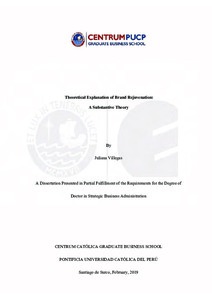| dc.contributor.advisor | Guevara Moncada, Rubén | |
| dc.contributor.author | Villegas, Juliana | |
| dc.date.accessioned | 2019-02-06T21:10:04Z | |
| dc.date.available | 2019-02-06T21:10:04Z | |
| dc.date.created | 2019-02 | |
| dc.date.issued | 2019-02-06 | |
| dc.identifier.uri | http://hdl.handle.net/20.500.12404/13401 | |
| dc.description.abstract | The purpose of this research study that uses a qualitative approach was to propose an
intermediate theory using the Grounded Theory, that would theoretically explain the brand
rejuvenation phenomenon. To do this, several criteria were defined that lead to a sample of
18 brands that had undergone a rejuvenation process. As sources of evidence, in depth
interviews were held with senior executives that participated in the branding work, as well as
a documentary review of the rejuvenation process for each of these brands, an in-depth
literature review and an evaluation by 10 experts who compared the aging brand and the
rejuvenated brand for each of the 18 cases. After interpreting the primary and secondary data
using the Atlas Ti 8 software and comparing its results with scattered knowledge found in the
literature review, an intermediate theory emerged, that responded to the study’s questions on
three topics: The symptoms of brand aging, the brand rejuvenation intervention process, and
the results of brand rejuvenation.
This allowed concluding that, to explain the brand rejuvenation process, it is necessary
to go back to its causes, understand its motivators and purposes, implement a process for
planning, executing and evaluating the rejuvenation phenomenon, and investigating its
results. A step-by-step process was also identified that explains how the brand rejuvenation
process occurs and that accounts for the reversal of the brand aging process. It was reaffirmed
that brand rejuvenation is necessary because it responds to different requirements of the
environment, of the firm and to certain strategic marketing goals. Proposals for future studies
include proving, quantitatively, the 16 propositions put forward in this research study that
provide a theoretical explanation for brand rejuvenation. Another suggestion is to expand the
scope with failed cases, other brand taxonomies, or a review of the phenomenon from a
demand perspective. | es_ES |
| dc.language.iso | eng | es_ES |
| dc.publisher | Pontificia Universidad Católica del Perú | es_ES |
| dc.rights | info:eu-repo/semantics/closedAccess | es_ES |
| dc.subject | Marcas de fábrica | es_ES |
| dc.subject | Comportamiento del consumidor | es_ES |
| dc.subject | Investigación cualitativa | es_ES |
| dc.title | Theoretical explanation of brand rejuvenation: a substantive theory | es_ES |
| dc.type | info:eu-repo/semantics/doctoralThesis | es_ES |
| thesis.degree.name | Doctor en Administración Estratégica de Empresas | es_ES |
| thesis.degree.level | Doctorado | es_ES |
| thesis.degree.grantor | Pontificia Universidad Católica del Perú. CENTRUM | es_ES |
| thesis.degree.discipline | Administración Estratégica de Empresas | es_ES |
| renati.advisor.dni | 48642063 | |
| renati.advisor.orcid | https://orcid.org/0000-0002-4795-2557 | es_ES |
| renati.author.cext | AP688598 | |
| renati.discipline | 413038 | es_ES |
| renati.level | https://purl.org/pe-repo/renati/level#doctor | es_ES |
| renati.type | http://purl.org/pe-repo/renati/type#tesis | es_ES |
| dc.publisher.country | PE | |
| dc.subject.ocde | https://purl.org/pe-repo/ocde/ford#5.02.04 | es_ES |





